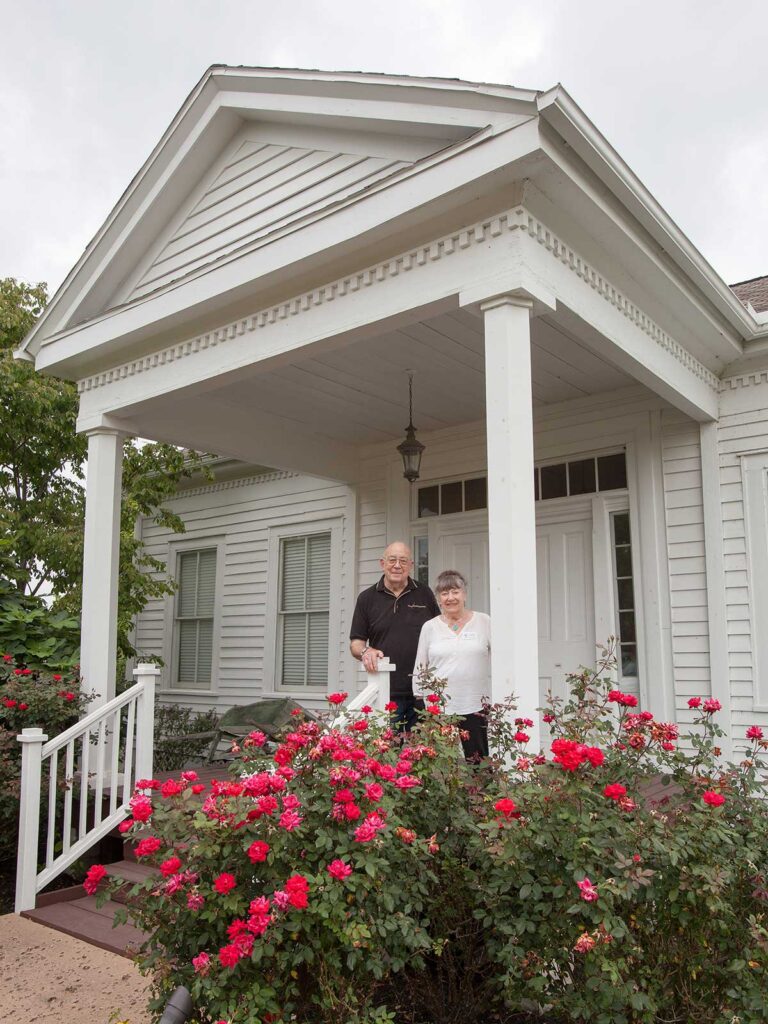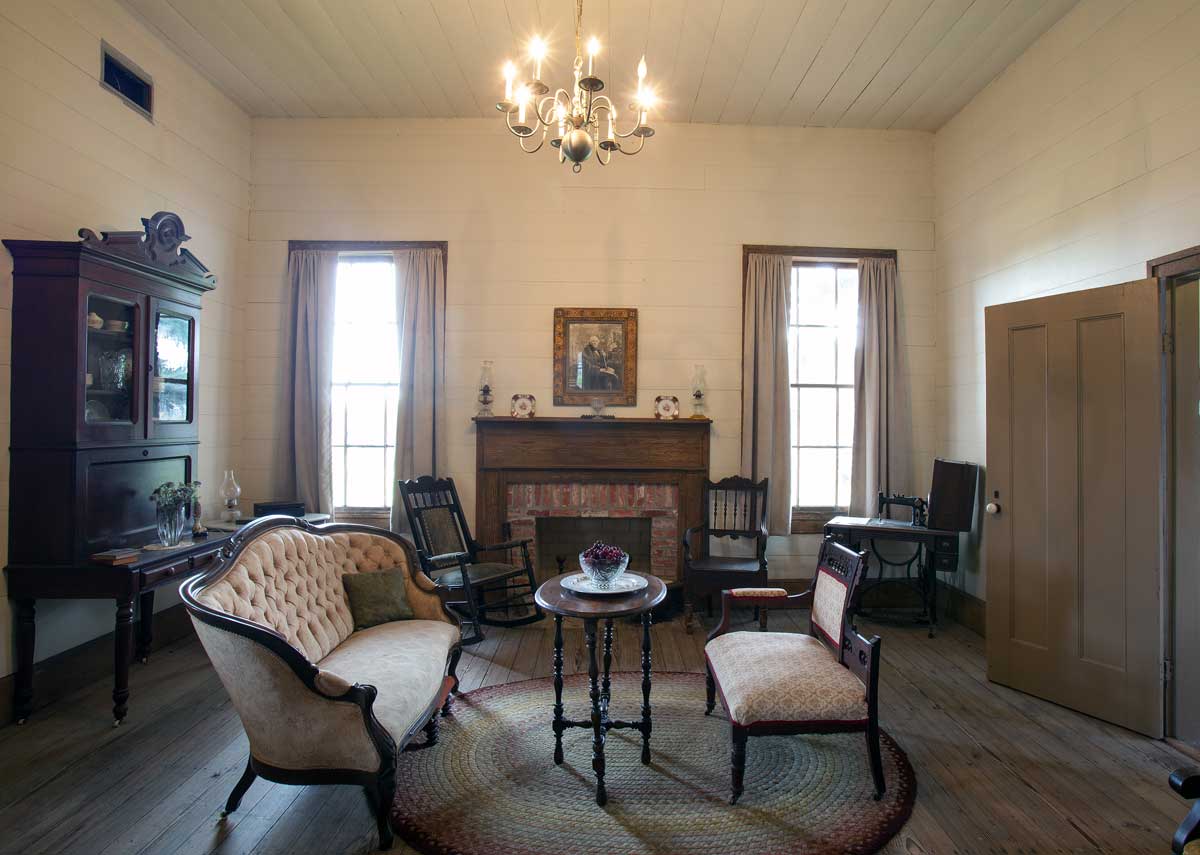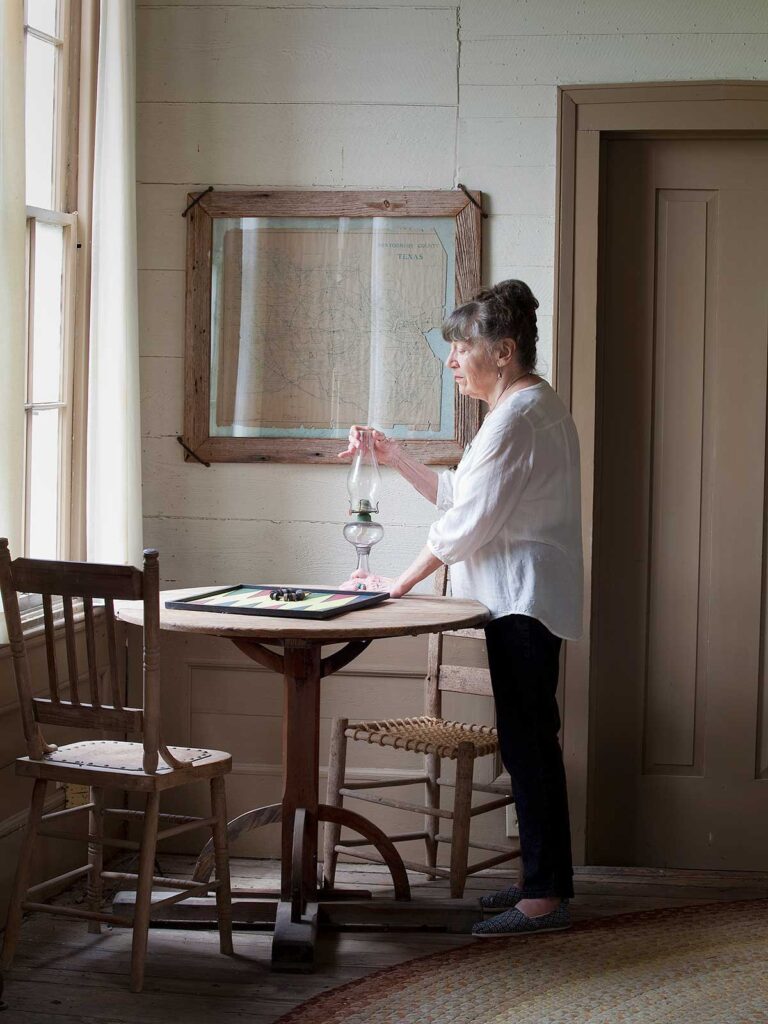As the oldest community in Montgomery County—in fact, once its county seat—the town of Montgomery dresses up its rich history each year during early December. High school madrigal singers, garbed in holiday attire, carol their way through downtown.
Children of all ages fill bags with fancifully decorated cookies, and grownups shop for handmade gifts. Families file through a dozen or so historical buildings, most built more than a century and a half ago. Candelarias dramatically lead visitors on the candlelight homes tour.
At each venerable structure—from frontier cabins to Victorian cottages—historical interpreters in period clothing regale listeners with stories of Montgomery’s 19th-century heyday.
The Montgomery Historical Society, founded in the 1950s, sponsors the annual Christmas in Historical Montgomery event—set for December 9 this year. It’s a fundraiser to help maintain the society’s seven historical buildings, which are open for tours year-round.
A good place to start is the N.H. Davis Pioneer Complex and Museum. Other society-owned properties include the 1892 gingerbread-style Addison-Gandy House, the 1902 Old Baptist Church and the Old Methodist Churchyard Cemetery.
The museum is housed in the cottage of the late Nathaniel Hart Davis, an attorney and judge and Montgomery’s first mayor. It was built in 1851 using logs received as payment for legal fees. The pioneer home showcases period furnishings and memorabilia, including the judge’s original wood-burning stove.
Also on site is Davis’ law office as well as the 1880s law office of Judge Screven A. McCall, who later became Montgomery County’s district judge. A replica of the original 1839 sketch of the Lone Star Flag is one of the museum’s signature items.
Local physician Charles B. Stewart, a signer of the Texas Declaration of Independence, designed the iconic flag, which still serves as the symbol of Texas today. The original sketch remains in the state archives in Austin. In 1997 the Texas Legislature named Montgomery the Birthplace of the Texas Flag.

Billy Ray Duncan, left, Montgomery Historical Society president, and Julie Kohl, Fernland Historical Park chief docent, welcome visitors to the Arnold-Simonton House.
Jay Brittain

The dining room of the Arnold-Simonton House features a fireplace.
Jay Brittain
Fernland Park
The Montgomery Historical Society also owns the town’s oldest home and the county’s only structure listed on the National Register of Historic Places, the Arnold-Simonton House, located at Fernland Historical Park, a unique heritage village in a city park near downtown.
Handcrafted in 1845, the Greek-revival house was built for Dr. E.J. Arnold and his wife, Rhoda Ann Warner.
Unlike most Anglo-American settlers, who came from the Deep South, the couple moved to the Texas frontier in the 1830s from Connecticut. Arnold wanted his fancy frontier home to reflect Connecticut styling, so he designed classical doors, sidelights and transoms for each end of an enclosed hallway. A pair of rooms run along each side of the hallway and share interior double-fireplaces. In 1885 the grand home was sold to Reuben Davis Simonton, whose family lived there for the next 90 or so years.
“Among the items on display that tell the history of the house and of Montgomery, we’re lucky to display many Simonton family heirlooms such as a mantle clock and a writing desk,” said Julie Kohl, Fernland chief docent.
Fernland Historical Park also boasts three restored frontier log cabins that reflect the humble beginnings of 19th-century settlers. The oldest is the Jardine Cabin, built by Irish immigrant James Jardine around 1830 on land obtained from the Mexican government. The cabin reflects the simple functionality of a typical story-and-a-half, hand-hewn log cabin with front and back porches and a mudcat fireplace chimney.
The Crane Cabin was built a couple of years after the Civil War by Confederate veteran Nickolas Crane. The walls are pine logs left rounded on the outside and hand-adzed into a flat wall inside. When Fernland docent Eva Rains gives a tour of the cabin, she speaks with authority—she’s a direct descendant of Nickolas and Mary Ann Crane. She was recently involved with the complete restoration of an early portrait of the Cranes that remains proudly displayed at Fernland.
The third log home at Fernland is the Hulon House, built in typical Texas dogtrot style, later clad with clapboards. It’s furnished, as are all the log homes, with period or replica furnishings to reflect lifestyles of the day. Fernland also features a bell tower that displays the original bell from China Chapel, one of several freedman’s churches in Montgomery formed after African American emancipation in Texas in 1865.

A look at life in the mid-1800s at the Arnold-Simonton House, the oldest house in Montgomery, built in 1845.
Jay Brittain

A visitor rings a bell on the porch of the Crane Cabin, built right after the Civil War in present-day Angelina County.
Jay Brittain
The log cabins at Fernland were originally saved and restored by noted Houston preservation architect Benjamin Carroll Tharp and his wife, Mae. The Tharps moved the cabins and other frontier structures from their original locations to a wooded Montgomery County property they called Fernland. There, they lovingly restored and filled them with period furnishings.
In 1991, the Tharps donated the restored structures to Sam Houston State University. An 1840s tobacco plantation house, once used by Sam Houston as a hunting lodge, is one of the restored buildings.
To make the pioneer buildings more available to the public, the university moved the hunting lodge to the Sam Houston Memorial Museum in Huntsville and the log cabins to Montgomery. The log cabins ended up on city land that was named Fernland Historical Park to honor the Tharps’ push for preservation.
Commitment to Preserve
During the 1820s, when Texas was still part of Mexico, empresario Stephen F. Austin received a contract from the Mexican government to settle hundreds of families in today’s western Montgomery County. More settlers arrived during and after the establishment of the Republic of Texas.
Montgomery County was created in 1837 by an act signed into law by Texas President Sam Houston. The town of Montgomery was situated on a stagecoach line from Huntsville to Houston. The town became the focal point for immigrants, who cut logs they used to build homes and cleared land that became farms.
By the 1850s, cotton growers from the Old South arrived with enslaved workers to establish plantations that brought an economic boom. Plantations fell on hard times following the Civil War, but the next two decades brought economic revival as new railroad lines opened new markets for agriculture and lumbering.

Chief Docent Julie Kohl adjusts a candle in the Arnold-Simonton House.
Jay Brittain

Local historian Billy Ray Duncan explains the half-dovetail notching used to construct early pioneer cabins.
Jay Brittain

A real crane stands on a rock near a crane statue, foreground, overlooking the historical park’s small lake.
Jay Brittain
In those boom days, Montgomery became the county seat, and residents built many fine homes. The town lost the county seat to Willis, got it back again, then permanently lost the honor to Conroe in 1889. That’s still a sore spot with locals, says Billy Ray Duncan, Montgomery Historical Society president, only half-jokingly.
“Honoring our history has always been important in Montgomery,” Duncan said. “The historical society was instrumental in creating an attitude that promotes history and tells our story. For instance, when I was in high school, we weren’t told that the Texas flag was designed here. Now it’s one of our most treasured honors.”
The desire to preserve history has been strongly supported by the city of Montgomery, notes Mike Newman, president of Fernland Inc., the nonprofit volunteer board that guides Fernland.
“Support from our local government is one of the main reasons we’re one of the region’s few towns with so many historical buildings,” Kohl said. “Not only is it important to maintain your heritage, but it brings lots of visitors to town. There’s a value in remembering how people lived and how they built their homes with pride. When done right, they were built to last.”
The same could be said for Montgomery’s commitment to historic preservation.

Adze markings show the hand labor required to turn round trees into square walls on the Jardine Cabin.
Jay Brittain


